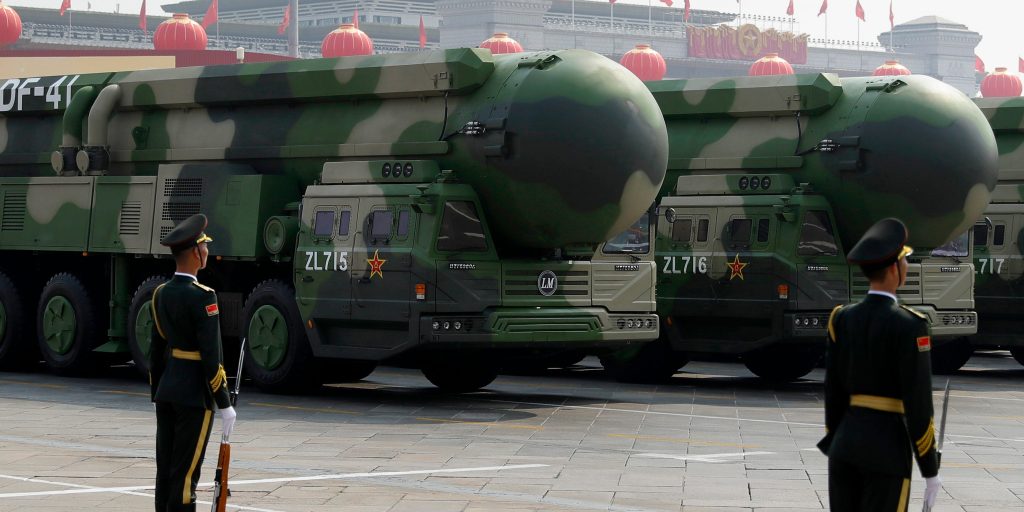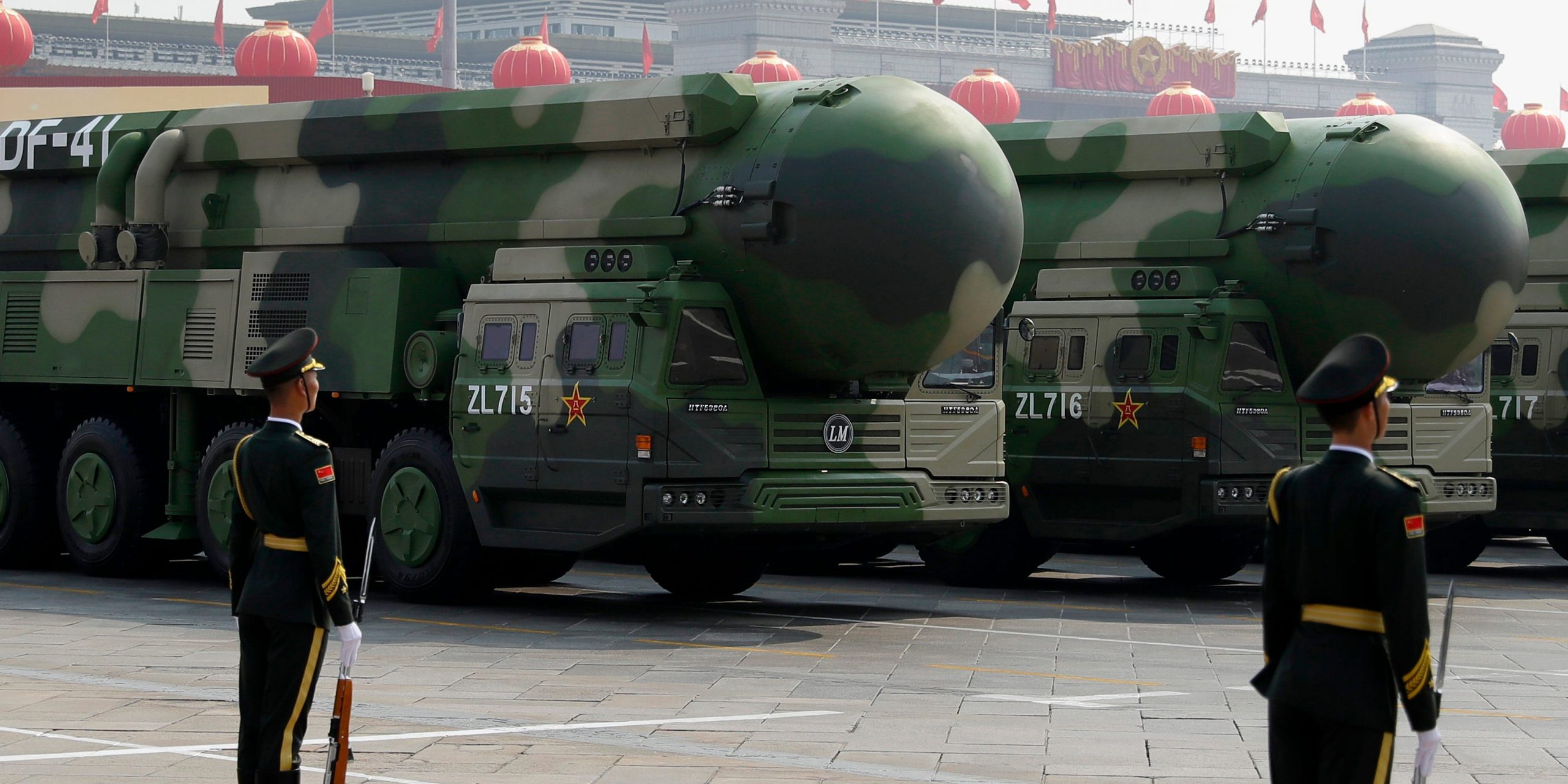
AP Photo/Mark Schiefelbein
- Experts have identified what appear to be hundreds of new missile silos under construction in China.
- It is assumed that these silos will house the new DF-41 intercontinental ballistic missiles.
- Silos are vulnerable, but with enough of them and the right missiles, they can be advantageous.
- See more stories on Insider's business page.
China appears to be building hundreds of new silos to house intercontinental ballistic missiles, raising some questions about its intentions. To some experts Insider talked to, the huge silo fields look to be China's answer to rivals that have a lot more nuclear weapons.
In recent months, analysts with the Federation of American Scientists and the Middlebury Institute of International Studies relying on commercial satellite images have found that China is constructing what looks like around 250 new missile silos. It previously had only about 20 silos.
Silo construction is clearly visible and appears to be underway in Hami in Xinjiang province, Yumen in Gansu province, and Jinlantai in Inner Mongolia. The Hami site, which is still in the early stages of construction, is roughly 300 square miles and the Yumen site is around 700 square miles.
The silos are grouped but spaced roughly two miles apart in grid patterns, which is very different from the way China has approached silos in the past. The country's older silos are scattered, isolated, and somewhat camouflaged.
Sharing a report on the findings, US Strategic Command tweeted this week that "the public has discovered what we have been saying all along about the growing threat the world faces and the veil of secrecy that surrounds it."
Silos are much more vulnerable than some alternative launch platforms because they do not move, making them easy to find and even easier to target, but with enough silos and modern missile technology, they can be advantageous.
A lot more silos
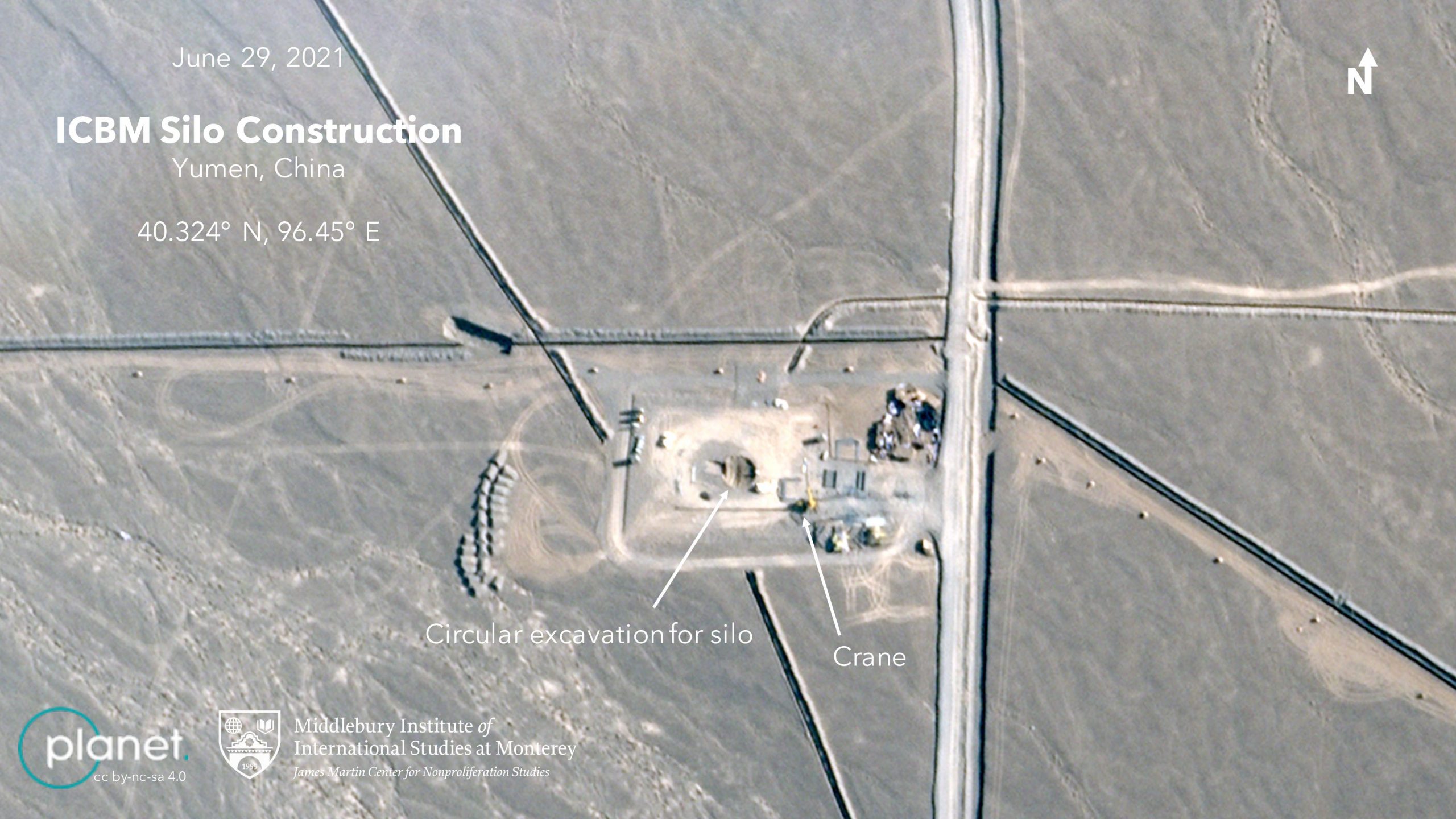
Planet Labs/Center for Nonproliferation Studies at MIIS
Having a significant number of missile silos makes it more difficult for an adversary to eliminate a country's nuclear weapons before it has the chance to use them, and it is not even necessary to fill them all with missiles.
Jeffrey Lewis, director of the East Asia Nonproliferation Program at MIIS, suspects that China will employ a "shell game" strategy, putting missiles in only some of the silos. The US military pursued a similar strategy during the Cold War.
"If there are silos, you have to take them seriously as being full. That is precisely how the shell game works. You don't know, and you have to assume that," he said.
The "shell game" strategy is a reasonable approach if China wants to retain its retaliatory capability while maintaining its minimum deterrence stance. Even empty silos would potentially help deter an adversary given the cost of destroying missile silos versus the cost to build them.
"They can add silos more cheaply than we can add missiles with warheads," Lewis explained.
He said that the layout of the silos, which are far enough apart that a single warhead could not take out multiple silos but close enough that missiles could be shuffled among the silos as needed, suggests a "shell game" strategy.
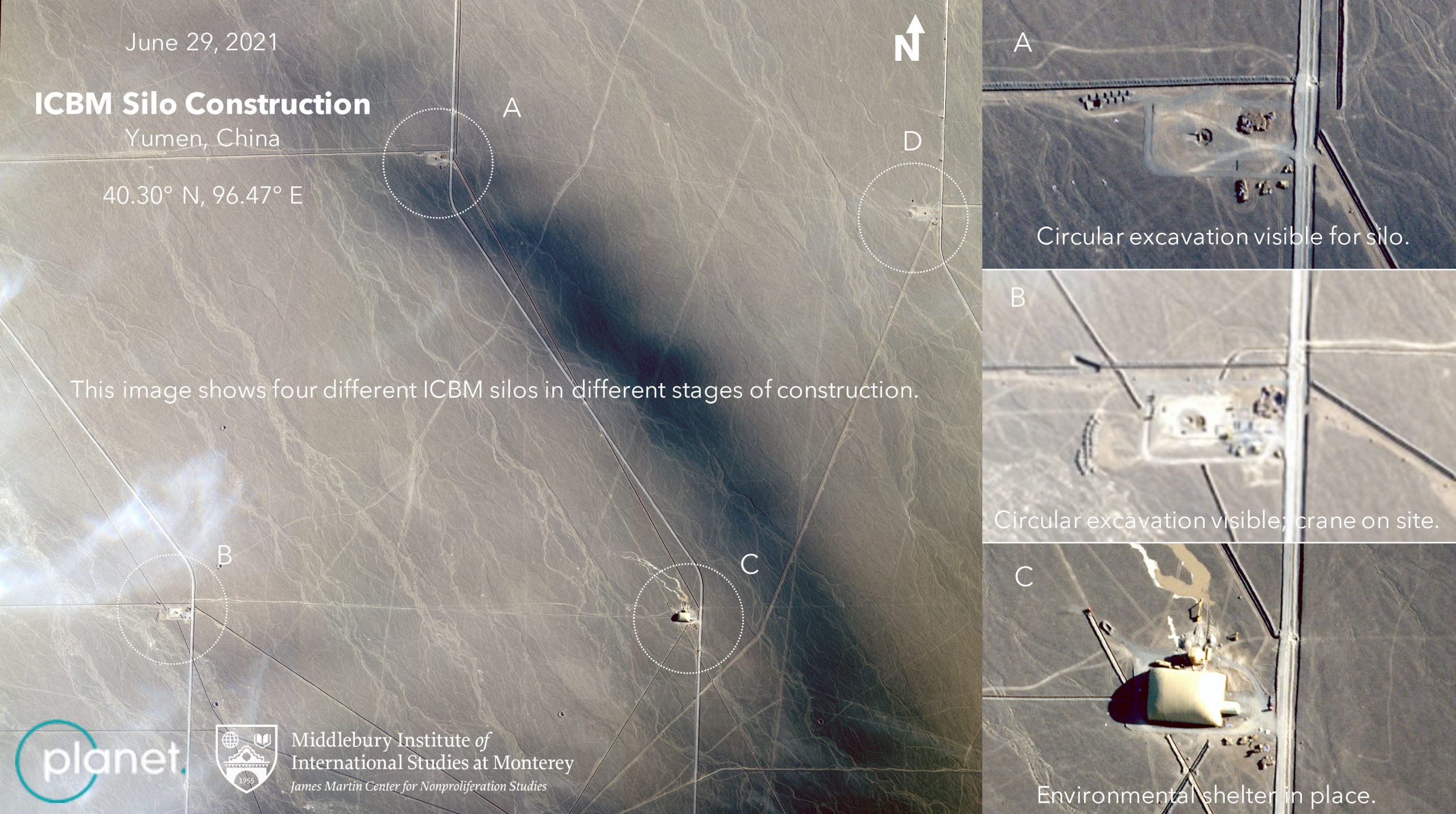
Planet Labs/Center for Nonproliferation Studies at MIIS
Hans Kristensen, director of the Nuclear Information Project at FAS, acknowledged that a "shell game" strategy is certainly possible.
"You could say the Chinese have created a nuclear sponge by building all these silos," Kristensen said. "If it is a shell game, then it is partly the intention to force United States planners to waste a lot of warheads trying to chase down loaded missile silos."
"But if you're China, is that necessarily the way you think, or is it much more straightforward?" he asked.
Kristensen and his colleague Matt Korda wrote in a report on developments in Hami this week that China's silo construction may represent "the most significant expansion of the Chinese nuclear arsenal ever."
The pair suggested that China may have decided it needs more silos for a more robust nuclear force that ensures it can deliver a retaliatory strike able to break through an adversary's defenses and hold strategic positions at risk.
It could also be a matter of national prestige, part of China's pursuit of great power status. China has yet to acknowledge the silo construction, so its intentions are unclear.
The Chinese arsenal of nuclear weapons is significantly smaller than those of the US and Russia, both of which have thousands of nuclear weapons, but if it is expanding the size of its arsenal, it could be seen as a departure from minimum deterrence.
Kristensen and Korda wrote that "the build-up is anything but 'minimum' and appears to be part of a race for more nuclear arms to better compete with China's adversaries."
Better missiles
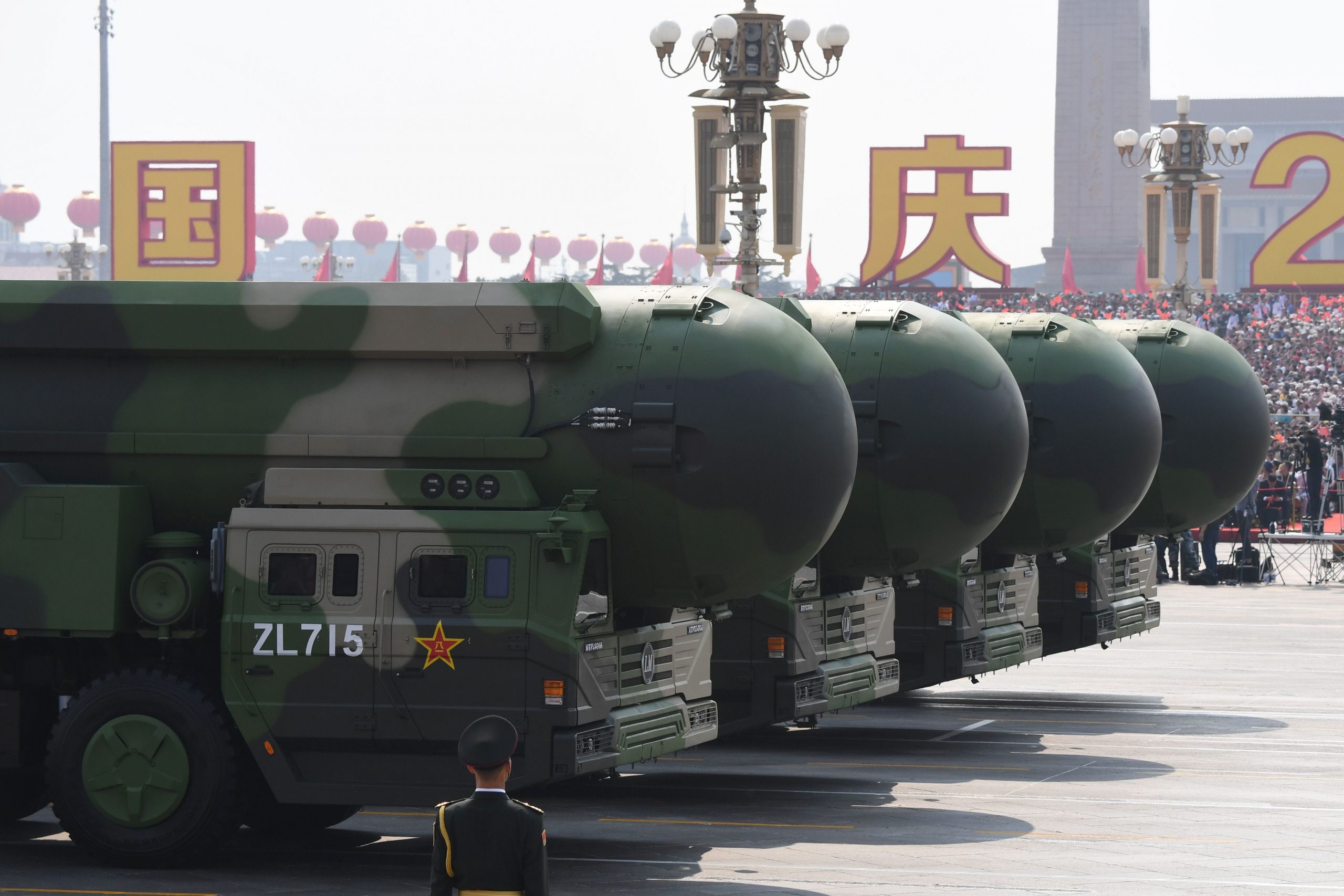
GREG BAKER/AFP via Getty Images
The new silos China appears to be building are positioned at more secure locations deeper in the country, likely improved compared to China's older silos, and will likely be armed with better ICBMs.
Kristensen explained that a motivating factor for ongoing construction efforts might simply be a desire for "harder silos with better missiles capable of responding in a way that ensures the survivability of the retaliatory capability."
Adm. Charles Richard, the head of US Strategic Command, explained to lawmakers in April that China is "moving to solid fuel intercontinental ballistic missiles, silo-based," describing the weapons as "very responsive compared to a liquid fuel one."
At least some, if not all, of the silos under construction are believed to be for China's new solid-fueled DF-41 ICBM, which can be fueled in advance, is less dangerous to work with, and requires far less preparation time than the older liquid-fueled silo-based DF-5 missiles.
The DF-41 was first showcased during a military parade on a transporter erector launcher, indicating it, like many others in the Chinese arsenal, would be a road-mobile missile.
The problem is that the size and weight of the missile hinders mobility in this configuration.
"While it's mobile, it's going to tear up your roads," Lewis explained. "It is going to have trouble getting over bridges. It has a terrible turning radius. It is not really able to go offroad." And those are not the only potential issues.
Xu Tianran, an Open Nuclear Network analyst, said that the "DF-41 TEL is very large," explaining that "with today's and future surveillance technology, the mobile platform would also bear more risk of being taken out or suppressed."
"We focus on road mobility because it seems almost like a submarine on land," Lewis said, "but we kind of gloss over the real limitations of those systems, especially when you're handling a big missile." A silo might actually be a better choice comparatively.
The US, though it considered road-mobile missiles, keeps its ICBMs in a collection of roughly 450 silos.

Planet Labs/Center for Nonproliferation Studies at MIIS
Fielding the new solid-fueled DF-41 ICBMs in silos would also allow China to shift its silo-based force to a launch-on-warning (LOW) status to increase survivability.
"They have the radars. They have the missiles that are ready to go. It would be the easiest thing in the world for them to just keep the ones in the silos on alert," Lewis said.
In its latest report on China's military power, the Pentagon said that evidence, including "further investment in silo-based forces," indicates "that China seeks to keep at least a portion of its force on a LOW posture."
Nuclear modernization and posture changes are always challenging though because it is difficult for a country to bolster its own security without creating unease elsewhere.
"On the one hand, you have to deter an adversary from using nuclear weapons, but you don't want to deter them or threaten them so much that they take steps to increase their force and its capability and its readiness in such a way that you end up facing something that is more dangerous than it was before," Kristensen said.
There is still a lot of uncertainty surrounding the silos. Pushing for arms control, Kristensen said that "the United States and China have to be really careful about how they move forward on this because it can very rapidly spin out of control."
Dit artikel is oorspronkelijk verschenen op z24.nl

